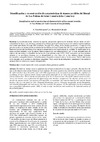Please use this identifier to cite or link to this item:
https://accedacris.ulpgc.es/jspui/handle/10553/57367
| Title: | Identificación y reconstrucción de características de tramos perdidos del litoral de Las Palmas de Gran Canaria (islas Canarias) | Other Titles: | Identification and reconstruction of characteristics of lost coastal stretches in Las Palmas de Gran Canaria (Canary Islands) | Authors: | Pérez Hernández, Eva Hernández-Calvento, Luis |
UNESCO Clasification: | 250607 Geomorfología | Keywords: | Coastal transformation Urban sprawl Lost heritage |
Issue Date: | 2017 | Project: | Caracterización de Procesos Socio-Ecológicos de Los Sistemas Playa-Dunas de Canarias Como Base Para Su Gestión Sostenible Análisis de Procesos Naturales y Humanos Asociados A Los Sistemas Playa-Duna de Canarias |
Journal: | Geotemas (Madrid) | Abstract: | La transformación del territorio ha supuesto una pérdida importante de elementos del patrimonio natural y
cultural.Este ha sido el caso del litoral oriental de Las Palmas de Gran Canaria. La expansión urbana experimentadapor
esta ciudad entre finales del siglo XIX ymediados del siglo XX, obligó, en las décadas posteriores, a ocupar la costa
para dar cabida a la ampliación de la carretera de Las Palmas de Gran Canaria-Sur (GC-1), y su prolongación hasta el
Puerto de La Luz y de Las Palmas. Ello supuso la transformación del litoral oriental de la ciudad. La mayor parte de los
tramos costeros naturales, como las playas, fueron ocupados por esta infraestructura y, por lo tanto, desaparecieron. El
objetivo de este trabajo es identificar los tramos de costa perdidos entre 1879 y 2016, reconstruir sus características
naturales y las actividades humanas que se desarrollaban en ellos. Para ello se han utilizado fuentes históricas
documentales, cartografía histórica, fotografías aéreas, fotografías convencionales y fuentes orales. Toda la información
se ha integrado en un sistema de información geográfica (SIG), con el fin de cartografiar, caracterizar y reconstruir la
memoria histórica sobre estos espacios desaparecidos. The land use changes mean a significant loss of natural and cultural heritage’s elements. This has been the case of the Eastern coast of Las Palmas de Gran Canaria. The urban sprawl at the end of the nineteenth century and the mid-twentieth century, forced the coast in the following decades to be occupied, to accommodate the road between Las Palmas de Gran Canaria and the Southern part of the island (GC-1), as well as having to be extended to La Luz and Las Palmas Port. This meant the transformation of all the city Eastern coast. Most of the natural coastal stretches, such as the beaches, were replaced by this infrastructure and, therefore, disappeared. The objective of this work is to identify the coastal stretches lost between 1879 and 2016, to reconstruct their natural characteristics and the human activities that were developed on them. Historical documentary sources, historical cartography, aerial photographs, conventional photographs and oral sources have been used for this purpose. All this information has been integrated into a geographic information system (GIS), in order to map, characterize and reconstruct the historical memory of these missing places. |
URI: | https://accedacris.ulpgc.es/handle/10553/57367 | ISSN: | 1576-5172 | Source: | Geotemas ( Madrid ) [ISSN 1576-5172] (17), p. 191-194 | URL: | http://dialnet.unirioja.es/servlet/articulo?codigo=6398559 |
| Appears in Collections: | Actas de congresos |
Page view(s)
93
checked on Jan 23, 2024
Download(s)
145
checked on Jan 23, 2024
Google ScholarTM
Check
Share
Export metadata
Items in accedaCRIS are protected by copyright, with all rights reserved, unless otherwise indicated.
